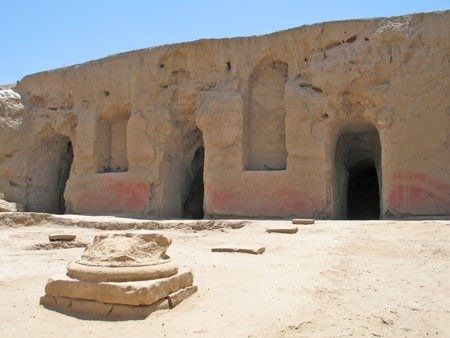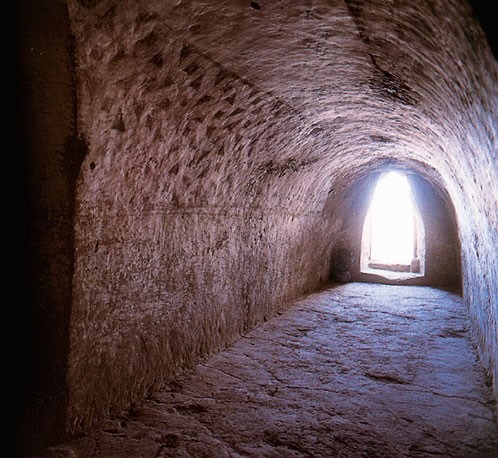BUDDHIST CULT COMPLEX OF KARATEPA IN UZBEKISTAN – Southern Uzbekistan
The Buddhist cult complex of Karatepa “black hill” (2-4 centuries AD), covering a surface of 7 hectares. As a result of excavations it has been established that a major Buddhist religious centre existed on the Kara-tepe hill in the periphery of the vast town-site of Old Termez.
The site is formed some outdoor constructions, which contained a stupa (Buddhist religious building) together with several caves dug in the hill. The walls of the vihar preserved many inscriptions in various languages-Syriac, Arabic, Bactrian, etc. The complex included more than 30 temples and several temple-monastery complexes, with structures made of cave rooms cut in sandstone mounds; as well as surface buildings made of pahsa and unbaked brick with courtyards and gallery around the perimeter. The excavation of the Buddhist site unearthed by A. Strelkov in 1928, who examined three caves and suggested that these were the remains of a Buddhist cave monastery. Karatepa is a unique monument of the culture and art.
1. It is one of the few Central Asian monuments of the Kushan period.
2. It is the earliest, or at least one of the earliest, Buddhist monuments in the vast region.
3. It is the only known Buddhist cave monastery.
In ancient times, there was an important caravan route from the areas of modern Afghanistan and northern India to the Central Asian interfluve and then to East Turkestan and China. The city was located on one of the busiest sections of this route-on the road from Balkh, the capital of ancient Bactria, to Samarkand, the political and cultural center of Sogdiana (Sogda). An unusual (most likely cult) purpose of the buildings in Karatepa is also evidenced by the composition of the ceramics found here. Of the outstanding value of this Buddhist centre in the Kushan Empire remains one of the discovered label name — “KaDeWe-ka Vihara” (“the Royal monastery”), another mention of “Vihara Guevara”. The Buddhist-monastic character of the buildings in Karatepa is evidenced by the finds of fragments of Buddhist ganch statues, and various images of lotus flowers, and in some ground buildings fragments of frescoes have been preserved. One of these drawings depicts a Buddha who overcame all earthly temptations, such as pride, revenge, bitterness, and managed to reach the seventh stage of dhyana.
In accordance with the terrain, there were several dozen large cave complexes. Materials from Karatepa confirm the above information of Buddhist texts about the assimilation and spread of Buddhism by the Bactrians (Tochars). The very fact of the existence of a large monastery in Termez, the finds of clay vessels with gift inscriptions in Sanskrit and Kushan script-speak about the assimilation of the local people of the religion of Buddhism, Indian writing and language. The specific layout of the monastery buildings (the widespread use of shrines with three and four bypass corridors) indicates the contribution of local Buddhists to the development of Buddhist architecture.




